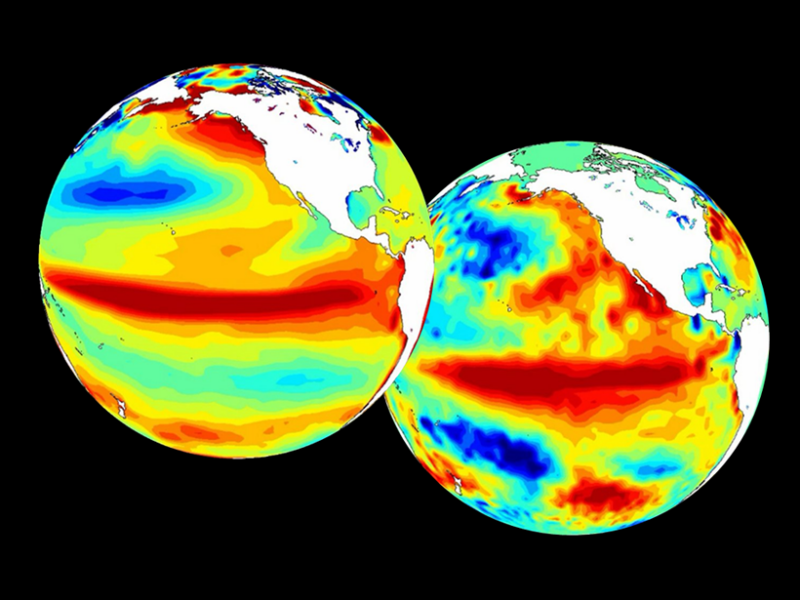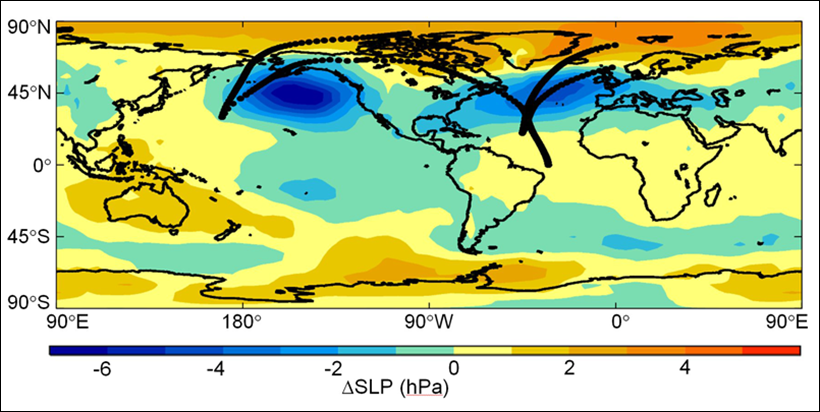27 November 2017
William J. Merryfield,
bill.merryfield@canada.ca
Francisco J. Doblas-Reyes, Laura Ferranti, Jee-Hoon Jeong, Yvan J. Orsolini, Ramiro I. Saurral, Adam A. Scaife, Mikhail A. Tolstykh, and Michel Rixen
Better forecasts, new products: The World Climate Research Programme coordinates research aimed at improving and extending global climate forecasting capabilities.

As the science underlying climate forecasts continues to develop, their accuracy can be expected to increase. One group of researchers contributes to this process through a program of numerical experimentation. Shown here is a comparison of departure from normal sea surface temperatures in February 2016. On the right are observed anomalies, whereas the left shows anomalies as forecast by Environment and Climate Change Canada’s CanCM4 climate model 12 months earlier, averaging over an ensemble of 10 forecasts. Warm colors indicate higher than normal temperatures; cool colors represent lower than normal temperatures. Credit: Jean-Philippe Gauthier and Juan Sebastian Fontecilla, ECCC/CCMEP
Climate forecasts predict weather averages and other climatic properties from a few weeks to a few years in advance. Increasingly, forecasters are using comprehensive models of Earth’s climate system to make such predictions.
Researchers also use climate models to project forced changes many decades into the future under assumed scenarios for human influence. Those simulations typically start in preindustrial times, so far in the past that details of their initial states have little influence in the present era. By contrast, climate forecasts begin from more recent observed climate system states, much like weather forecasts. For this reason, they are sometimes referred to as “initialized climate predictions.”
Climate forecasts are produced at numerous operational [Graham et al., 2011 International Journal of Climatology ] and research centers worldwide. Models and approaches vary, and by coordinating research efforts, the modeling community can make even greater progress. The Working Group on Subseasonal to Interdecadal Prediction (WGSIP) of the World Climate Research Programme (WCRP) facilitates such coordination through a program of numerical experimentation—evaluating model responses to different inputs—aimed at assessing and improving climate forecasts.
WGSIP currently supports a project that archives hindcasts; this is a major community resource for climate forecasting research. It also supports three additional targeted research projects aimed at advancing specific aspects of climate forecasting. These projects examine how well climate forecast models represent global influences of tropical rainfall, assess how snow predictably influences climate, and study how model drifts and biases develop and affect climate forecasts.
Multiple Model Archive of Hindcasts
Climate varies naturally over a wide range of timescales, driven by processes within and interactions between the atmosphere, ocean, and other components of the climate system such as land, sea ice, and the biosphere. These factors combine with long-term changes forced largely by human influences on the concentrations of greenhouse gases and other atmospheric constituents. Together, these natural variations and forced long-term trends affect society in countless ways.
Because of the innate complexity of these interacting natural systems, analysis of multiple models from different forecasting systems is a key to better understanding climate variability and its prediction. To support such studies, WGSIP initiated the Climate-system Historical Forecast Project (CHFP), under which historical forecasts, or hindcasts, from many prediction models are permanently archived [Tompkins et al., 2017].
Hindcasts test models by seeing how well they can replicate events or trends that have already happened. All models require these hindcasts to make useful climate forecasts because they enable correction of model biases and estimation of historical skill. In addition, they provide an invaluable resource for analyzing and comparing the properties of climate forecast models, assessing the quality of the forecasts themselves, and exploring multimodel forecasting methodologies.
Tropical Influences
The heaviest rainfall on Earth occurs over tropical oceans. As water vapor condenses to form droplets in the moist tropical air, the water releases substantial amounts of latent heat. This heat produces deep convection currents that propel the resulting clouds to great heights. The accompanying uplift turns into divergent horizontal winds near the tops of these clouds, high in the troposphere.
Variations in climate alter the patterns of tropical rainfall from year to year. Shifts in upper level divergent winds drive disturbances in atmospheric circulation. These disturbances, known as Rossby or planetary waves, propagate eastward and poleward away from the equator in the winter hemisphere and affect atmospheric circulation in the extratropical regions, outside of the tropics. Such tropical influences on extratropical climate are known as teleconnections (Figure 1).

Fig. 1. Averaged atmospheric response during winter in the Northern Hemisphere to recent El Niño events, connecting atmospheric changes in the tropics with those at latitudes farther north and south. Dots represent approximate pathways of planetary waves [after Scaife et al., 2017]. Colors show associated changes in sea level pressure (SLP) in hectopascals (hPa), indicative of atmospheric circulation changes. In the Northern Hemisphere, changes are clockwise for positive contours, represented by warm colors, and counterclockwise for negative contours, represented by cool colors; these directions are opposite in the Southern Hemisphere. Credit: Adam Scaife
In some regions of the tropics, climate variations are relatively predictable because strong couplings between the tropical ocean and atmosphere modulate climate on relatively slow oceanic timescales. The most prominent such modulation is the El Niño–Southern Oscillation.
Because the predictable tropical climate influences the less predictable extratropical climate through teleconnections, tropical predictability could enable skillful predictions of the extratropical climate.
These interconnections raise several important and related questions:
How much do tropical teleconnections contribute to extratropical climate variability?
How well are extratropical circulation responses to tropical climate variability represented in current climate models?
To what extent can improvements in the modeling of teleconnections improve the skill of extratropical climate forecasts?
To address these questions, the WGSIP teleconnection initiative is examining how well climate forecast models represent the chain of causation connecting variations in tropical rainfall to planetary wave forcing and propagation and hence to modulation of extratropical climate. A pilot analysis of one model [Scaife et al., 2017] is being extended to many models, drawing on the CHFP archive and other hindcast data sources.
Recent results [Molteni et al., 2015] indicate that teleconnections are more directly connected to tropical rainfall than sea surface temperature, which has often been used to infer teleconnection driving. In addition, climate forecast models show encouraging levels of skill at predicting seasonal rainfall in all tropical ocean basins during the Northern Hemisphere’s winter months, especially in the eastern and western Pacific.
Ongoing efforts will determine how well different models represent the sources and propagation of planetary waves driven by tropical rainfall. We will then relate those model attributes to skill in forecasting winter climate variations in the northern extratropics, including the Arctic and North Atlantic oscillations.
Snow Effects
Seasonal snow cover strongly influences surface reflectivity and exchanges of heat and moisture between the land and atmosphere across vast Northern Hemisphere regions. These land-atmosphere couplings can influence large-scale atmospheric circulation following horizontal and upward propagation of planetary waves into the stratosphere. Hence, year-to-year variations in snow could potentially serve as a source of predictability for cold-season climate. In addition, the springtime snow cover over the Himalaya-Tibet Plateau region could influence the onset of the Indian summer monsoon [Senan et al., 2016].
Whether such predictability can substantially benefit climate forecasts depends on the robustness of snow-climate influences and whether current models can adequately capture them. Many investigations have examined these issues but have come to differing conclusions depending on the methodology and specific observations or model employed [see, e.g., Jeong et al., 2013; Orsolini et al., 2013, and references therein].
The WGSIP SNOWGLACE initiative is addressing these issues through coordinated multimodel experiments comparing forecasts that use either realistic or average snow states. Through this initiative, we hope to learn more about the effects of snow on surface air temperature and circulation over subseasonal timescales and to assess and improve our capabilities for predicting subseasonal to seasonal snow cover.
SNOWGLACE currently involves seven participating institutions and welcomes additional participants. A data center being established at the Korea Polar Research Institute will help to facilitate these investigations.
Characterizing Imperfect Models
Although climate models are increasingly realistic, finite spatial resolution, approximations and uncertainties in representing small-scale processes, and other factors limit their accuracy. Each model thus simulates a climate that differs to some extent from that of the real world. When models are initialized from observed climate states, they inevitably drift toward their own biased climate [Sanchez-Gomez et al., 2016].
In addition, when models incorporate physically inconsistent initial atmospheric and ocean states, the resulting computational “shocks” can accelerate the development of errors [Mulholland et al., 2015]. These influences can be difficult to separate from the drift signal. These drifts, shocks, and biases can be estimated and removed from climate forecasts through various postprocessing methods informed by the hindcasts for that model.
Model drifts and biases are important in their own right because they contain information about the nature and causes of model imperfections. Even though drifts can be approximately removed, the correction procedures themselves may introduce errors, and drifts and biases still may degrade forecasts by distorting the model representation of the observed climate system.
To provide a multimodel framework for the study of model drifts and biases and their impacts on climate forecasts, WGSIP initiated the Long-Range Forecast Transient Intercomparison Project (LRFTIP). The project has developed a data archive describing drifts in many climate forecast models and seeks to establish a standard set of model diagnostics for characterizing drift behavior on timescales from days to months to years.
The project has so far exploited hindcast data sets that include the Subseasonal to Seasonal Prediction Project (S2S) for subseasonal forecasts, WGSIP’s CHFP for seasonal forecasts, and the Coupled Model Intercomparison Project Phase 5 (CMIP5) for decadal forecasts. We plan to add data from other climate prediction models and their hindcasts and particularly welcome experiments in which the same model has been initialized using different methods or different observational data sets. We invite institutions interested in contributing to consult the LRFTIP data guide and to contact project organizers.
Toward Improved Climate Services for Society
As the science underlying climate forecasts continues to develop, their accuracy can be expected to draw closer to natural limits of predictability. Realizing the potential utility of climate forecasts will require tailoring products for decision-making by different sectors and effectively characterizing and communicating forecast uncertainty. By advancing the science of climate forecasting, WGSIP projects are contributing to this process.
_________________________________________________________________
References
Graham, R., et al. (2011), Long-range forecasting and the Global Framework for Climate Services, Clim. Res., 47, 47–55, https://doi.org/10.3354/cr00963.
Jeong, J. H., et al. (2013), Impact of snow initialization on subseasonal forecasts of surface air temperature for the cold season, J. Clim., 26, 1956–1972, https://doi.org/10.1175/JCLI-D-12-00159.1.
Molteni, F., T. N. Stockdale, and F. Vitart (2015), Understanding and modelling extra-tropical teleconnections with the Indo-Pacific region during the northern winter, Clim. Dyn., 45, 3119–3140, https://doi.org/10.1007/s00382-015-2528-y.
Mulholland, D. P., et al. (2015), Origin and impact of initialization shocks in coupled atmosphere-ocean forecasts, Mon. Weather Rev., 143, 4631–4644, https://doi.org/10.1175/MWR-D-15-0076.1.
Orsolini, Y. J., et al. (2013), Impact of snow initialization on sub-seasonal forecasts, Clim. Dyn., 41, 1969–1982, https://doi.org/10.1007/s00382-013-1782-0.
Sanchez-Gomez, E., et al. (2016), Drift dynamics in a coupled model initialized for decadal forecasts, Clim. Dyn., 46, 1819–1840, https://doi.org/10.1007/s00382-015-2678-y.
Scaife, A. A., et al. (2017), Tropical rainfall, Rossby waves and regional winter climate predictions, Q. J. R. Meteorol. Soc., 143, 1–11, https://doi.org/10.1002/qj.2910.
Senan, R., et al. (2016), Impact of springtime Himalayan-Tibetan Plateau snowpack on the onset of the Indian summer monsoon in coupled seasonal forecasts, Clim. Dyn., 47, 2709–2725, https://doi.org/10.1007/s00382-016-2993-y.
Tompkins, A. M., et al. (2017), The Climate-system Historical Forecast Project: Providing open access to seasonal forecast ensembles from centers around the globe, Bull. Am. Meteorol. Soc., https://doi.org/10.1175/BAMS-D-16-0209.1.
See the full article here .
Please help promote STEM in your local schools.
Eos is the leading source for trustworthy news and perspectives about the Earth and space sciences and their impact. Its namesake is Eos, the Greek goddess of the dawn, who represents the light shed on understanding our planet and its environment in space by the Earth and space sciences.

